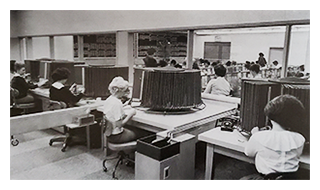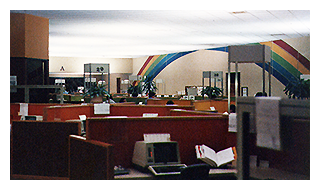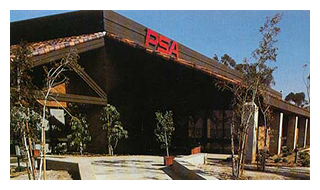If you can add information to a year or you think the information provided is incorrect, email Michael.
1947
Doug Kelley, one of PSAs first employees, had a special skill for finding second-hand airplanes, airplane parts, business machines, and miscellaneous pieces of equipment. He remembered that when Convair was manufacturing B-24’s at its Lindbergh Field plant during the war, part of the production line was outside, so it was necessary for them to build portable toilets, called outhouses. They measured 15x20 feet and had a partition down the middle to separate the women from the men. When military production ceased after the war, the outhouses remained in place because Convair had no further use for them. Convair had no objection to Kelley dragging off one of the buildings to the front of the Friedkin hangar at the terminal end of the airport.
1949
Reservations for flights north were handled in San Diego and flights south were handled in Oakland. Independent agents were used at San Diego, Burbank, and Oakland airports until December 26, when PSA hired their own agents. So technically, PSAs first ‘reservation’ agents were Parker Snow in San Diego, Bob Crandall in Burbank, and Floyd E. ‘Wes’ Wescott in Oakland. A switchboard was normally located in a room behind the counter. Agents were often asked to do a variety of work (i.e., reservations, counter, gate and sometimes stewardess on the flight).
1951
San Francisco service started July 20. PSA was given limited space at San Francisco for aircraft operations, but no counter space, so ‘reservations’ was handled on the sidewalk area in front of the terminal.
1956
In the summer, PSA wanted to update Burbank facilities at the Lockheed Air Terminal, station employees and Vice President Doug Kelley volunteered to do the work and save the $30,000 budget. Facilities were redecorated and new equipment added (i.e., new telephone control board – PBX). Burbank employees also installed sound-proofing materials in the offices. The new PBX offices were near boarding ramps and arriving or departing aircraft which caused reservationists to yell “huh?” or “what?” as they strained to hear.
1957

PSA moved into the new main office located at 3100 Goddard Way, off Lindbergh Field, and east of PSAs maintenance hangar. Reservations remained at the airline terminal off Pacific Highway. The reservation office in San Francisco was remodeled and improved.
1959
Friedkin had to revise reservations to adjust (i.e., increased capacity, new schedules, etc.) for the upcoming deliveries of the new Lockheed Electra L-188. While lower fares had always made making reservations easy, the new aircraft being pressurized and air-conditioned, made selling reservations much easier than the current fleet of hot, ear-popping DC-4’s.
1960
PSAs expansion resulted in reservations offices running out of space. A centralized reservation system with new telephone equipment was installed at 323 Geary Street in San Francisco and 1717 North Highland in Burbank. The San Diego reservations office was remodeled and enlarged to increase worker comfort, including a crew lounge, a private office for Floyd E. ‘Wes’ Wescott who had moved to San Diego to take over reservations, and a supply room.
1961
San Diego remodeled again and the reservation staff, which had grown to 11, was moved to a newly constructed, air-conditioned office building next to PSAs main office on the west side of Lindbergh Field.

1962
The San Diego Harbor Commission issued PSA a permit to erect a 12,000 square-foot building at Lindbergh Field which enlarged the reservations office to provide room for an NCR 315 computer which PSA had on order.
1963
Reservations were increasing at all three cities served by PSA: San Diego, Los Angeles, and San Francisco. It was a headache trying to maintain perfect reservations information. Jack ‘The Claw’ Duffy was brought into plan, program, install, and operate the NCR 315 computer. The NCR 315 was designed to provide instant reservations information for offices in San Diego, Los Angeles, and San Francisco, and each office was equipped with a large board of lighted numbers similar to a racetrack tote board that told the status of each flight. Installed at each agent’s work position was a machine containing a row of numbered keys, plus addition and subtraction bars, which was connected to the San Diego computer by telephone lines. The computer kept the lighted board current, and the reservationist was instantly provided with the availability of seats on every flight for a month in advance. The computer was never idle. Even while the reservations offices were closed, it completed a variety of tasks for PSA.
On March 12, the reservation calls did not go to the downtown offices in Los Angeles or San Francisco, they were instead routed to the main office in San Diego. Through a combination of ideas from PSA and Bell Telephone’s TelPak system, PSA became the first airline in the country with a completely automated reservations system. Rather than eliminate jobs, the new system required more people in San Diego to handle the increased workload. Forty-eight positions were installed in the new reservation’s office, complete with instant reference to flights via the computer. Local telephone numbers for PSA reservations were advertised in Los Angeles and San Francisco and all calls were automatically transferred to San Diego through long-distance telephone lines leased solely to PSA. The reservations offices in cities other than San Diego were closed.
1966
Ground was broken on a $5 million, 185,000 square-foot building on 14 acres at 3225 North Harbor Drive in San Diego to include offices and a hangar in the rear portion of the building. Office space was for maintenance, central reservations, administrative, and corporate.
1968
On February 15 PSA made the reservations office available 24-hours a day, but the lines were mostly silent from 1:00am to 5:30am.
The new building was completed in June. Andy Andrews and San Diego Mayor Frank Currin arrived for the dedication on the back of a large flat-bed truck which carried the former Convair outhouse PSA used for its first ‘reservations’ office in 1949.
The NCR 315 was replaced with the IBM 360 when reservations was moved to the new building July 1. The new computer utilized cathode ray tube and allowed reservationists to book a reservation instantly, citing the passenger’s name, flight, and control number, and could include connecting flight information and details concerning a reservation for rental car and/or hotel room.
At year’s end reservations was receiving up to 30,000 calls a day.
1969
Reservations director was Dean Hocking, and his assistant was Larry Fox. Larry Fox became director after Dean Hocking was promoted to Director of In-Flight Service.
1973
Increased passenger traffic prompted an expansion of the reservations staff from 84 to 140. New telephone equipment and a new computer were installed. It was 10 years ago that PSA had centralized reservations in San Diego. Where the current center received a daily average of 20,000 calls, agents on duty 10 years ago would have sat around contemplating their next phone call – often 15 minutes later.
Reservationists, who were non-union, crossed the picket lines when the machinists went on strike November 15 through December 23.
1976
With original management having left due to health concerns, being demoted, or being let go, new management took steps to eliminate all the ‘fun and games’ that took place, they felt a more serious environment would better compete with United Airlines. Because of the deteriorating ‘family’ feeling that took place within PSA, Bill Shimp created a communication committee with a member from each department, including reservations, to have a seat. Because all decisions still had to be approved by Paul Barkley and few executives attended meetings, the committee disbanded after a few months.
1977
With more computers being used throughout PSA, language on older machines was converted to be compatible with the IBM equipment used in most departments. Reservations started using CPARS (Compact Programmed Airlines Reservations System) which gave PSA the ability to handle more than 12 million calls annually while interfacing with the systems of other major airlines. 350 agents were able to construct a passenger’s flight itinerary and file it in the computer’s memory. The file could also include a passenger’s hotel and/or car rental booking and a reservation with a connecting airline.
Because CPARS seemed like such a cold, unfeeling name, department management sponsored a contest to rename the system. Kay Pilburn won an all-expenses paid trip to Hawaii by coming up with the name “The Happy Booker.’
In April, PSA was granted interline status for the first time with the signing of a joint fare agreement with American Airlines. Reservations was now allowed to provide reservations, ticketing, and baggage service to passengers with travel itineraries on both PSA and a larger trunk airline. In preparation for the new interline procedures, selected members of various departments, including reservations, were sent to Dallas for a three-week training program at the American Airlines Training Center. This was to introduce new interline procedures and SABRE, American’s computerized reservations system, which was used by PSA while the new computer system, CPARS, was being programmed. Those employees then returned to San Diego to help train personnel in their respective departments.

In mid-summer, Charles Hansen, was hired from Avis Rent-A-Car to be Director of Reservations and announced plans for a $1 million, 20,000 square foot, reservation center (SANRES) to be built on 9.3 acres at Scripps Ranch Business Park, 10 miles north of Lindbergh Field. He revealed that the new equipment would be designed and installed by Collins Automatic Call Distributors and have the capabilities of handling more than 10 million telephone calls per year. The Rockwell-Collins ACD system provided faster and more convenient telephone reservations service within the complex, for PSA and its customers throughout the USA.
The building would house 350 agents in a large central area, with room to expand, and equipped with such amenities as an employee’s lounge, cafeteria, lockers, administrative offices, training, and conference rooms. The room itself would be a virtual rainbow of colors, an effect created by using earth and sky tones in a continually changing pattern throughout the enclosure.

Unlike some airlines who moved to a large mid-western American city when obtaining a toll-free, 800 number, PSA decided to remain at home in San Diego. "Our reservations offices have always been located in our main office complex, however, we have run out of expansion space, necessitating the move," explained Bill Shimp, PSA president and CEO.
By August, the new complex was in the initial design phase. The firm of Robert L. Carli and Associates of Los Angeles was selected as architects. Samuelson's Brothers and Fisher Office Design of San Diego would handle interior design.
The reservations department established a design committee made up of agents to maintain communication among the employees on the design and building of their facility. Agents had submitted to Management, numerous valid suggestions on the design of the center. The number one request was windows, windows, and more windows.
1978
When it came time to design the new res complex, which was in the process of being built at Scripps Park in San Diego, PSA management left the designing to those people who would be most directly affected -- the res employees.
Chuck Hansen, VP-Marketing, asked res sales agents to become involved in the planning and write a letter giving their suggestions on interior design. Each included the reason why they wanted to be on the planning committee. From the more than 30 letters received, 10 members were chosen to coordinate the decor along with the designers.
At the main office, where res was currently situated, agents were lined up in rows with little or no privacy. The new plan provided for workstations which would accommodate eight persons, situated in a pattern of a four-spoke wheel.
The res center was completed in the fall and cost PSA about $1.5 million to build and design, and a move-in date was scheduled for January 1979.
David Rood joined PSA Reservations, serving as Manager of Rate and Tariff and the Group Desk. Rood worked closely with the Res Training Department to familiarize reservations with the interlining of passengers.
Joseph Opp, who also came from Avis Rent-A-Car, was named Director of Reservations in July. He had previously served in the capacity of reservations operations manager and was instrumental in helping coordinate and develop a more extensive reservations department.
On September 25, in the skies over San Diego, a Cessna crashed into the underside of a PSA B727 killing all 135 crew and passengers, as well as both Cessna occupants and seven people on the ground. A crisis team was put together and several reservationists were enlisted to help with the difficult task of repeating the company message of the moment to all callers.

1979
A grand opening for the new reservation center, located at 9850 Carroll Canyon Road, was held on January 31. The center ended up costing $2.5 million.
On December 14, PSA Reservations received its 10 millionth reservations call of the year, a first in the airline's history. Agent Phyllis Galloway booked Mr. D. Olson on a flight from OAK to LAX.
1984
PSA started to prepare for the upcoming computer system switch-over in March. Every agent had to successfully pass a test upon completing an 8-hour class.
Reservations made the switch from CPARS to SPARS computer systems on Sunday morning, June 3.
1985
On June 26, PSA announced their intention of opening a second reservations center (RNORES) in Reno, NV. After the announcement, agents felt the end was near for the San Diego office. Agents in San Diego were asked to decide whether or not to exercise seniority rights and accept a position in Reno or be laid off. With the threat of the San Diego center closing about 130 agents transferred.

The new reservation center located at 1155 Corporate Boulevard opened on December 21. The new one story, 16,000 square foot building, was located in the Dermody Business Park just southeast of Reno Cannon International Airport.
The center was built to handle calls north of Fresno which helped to reduce costs and call-waiting. If the Reno center became overloaded with calls from Northern California, calls were automatically rerouted to San Diego. The company expected to save at least $14 million in telecommunications costs over the first five years. The center's facilities included a dining room, classroom, lounge, locker room and administrative offices surrounding a spacious, carpeted area with banks of touch-screen computers.
PSA invested $1.4 million in its new high-tech "touch screen" computer system, designed to make it faster to make reservations and train reservation agents. The system, which used the Hewlett-Packard HP-150 terminals and software developed by PSA, was expected to cut by 40 percent the time needed to make a reservation by using a touch-sensitive computer screen that was operated with plain English rather than computer language. Training time was reduced agents from three weeks to as little as one day.
1986
PSA decided in late February to shut down the new computer system and return to the old keyboard reservation system used by the San Diego reservations center.
The system, called T-SPARS, turned out to be too simple for the complexities of recent air-fare structures, PSA spokeswoman Margery Craig said. For example, there could be as many as 19 different air fares between any two destinations.
As of March, the Reno center employed 290 agents; Scripps Ranch center had 230 agents.
On December 8, Chairman of the Board Paul Barkley, advised employees of an agreement to be purchased by USAir Group.
1987
On December 7, 1987, tragedy struck PSA once again. After being terminated, David Burke, a USAir employee, used a .44 Magnum revolver and shot his former supervisor and several crew members, including the pilot. This resulted in the aircraft crashing in Northern California and the loss of 43 crew and passengers. Reservations staff was once again part of the Crisis Team.
1988
PSAs last day of operations was on April 8, with the removal of corporate sign on April 9.
"There was only one PSA. And there has only been one PSA smile. Many other airlines adopted its innovations, but none could completely duplicate the enduring affection and commitment which existed between the airline, its passengers, and its fellow-workers. The grin will always be remembered, cemented in time by its employee memories and by those of many a former passenger. The Poor Sailors' Airline was a glorious flight through airline history." Gary Kissel
1995
The Reno office closed on September 20.
2001
In a company bulletin dated August 14, US Airways announced to employees that the reservation center located at 9850 Carroll Canyon Road in San Diego would be closed by October 19. The following is an excerpt from that bulletin:
"As you know, the nature of our call center business is changing. Call volume and traffic is down and US Airways is no different than many other companies in this regard. Our surplus staffing situation forced us to take a close look at how we do business. Additionally, as you may be aware, San Diego property is in the process of being sold. With this in mind and evaluating all relevant factors, San Diego was the best choice for the company to close in order to consolidate reservations operations."
The San Diego office closed on October 19, 2001. The day was a Friday and after the doors were closed a large contingency spent the next several hours at a local establishment. The reservations department still holds an annual reunion on the Saturday closest to the 19th of October. Even after 20 years, 50+ agents still get together and reminisce about the great times we had working at Pacific Southwest Airlines and in the reservations department.
2014
The property located at 9850 Carroll Canyon Road property was sold to Sudberry Properties.
2019
The property located at 9850 Carroll Canyon Road was demolished to make room for commercial/retail space.
